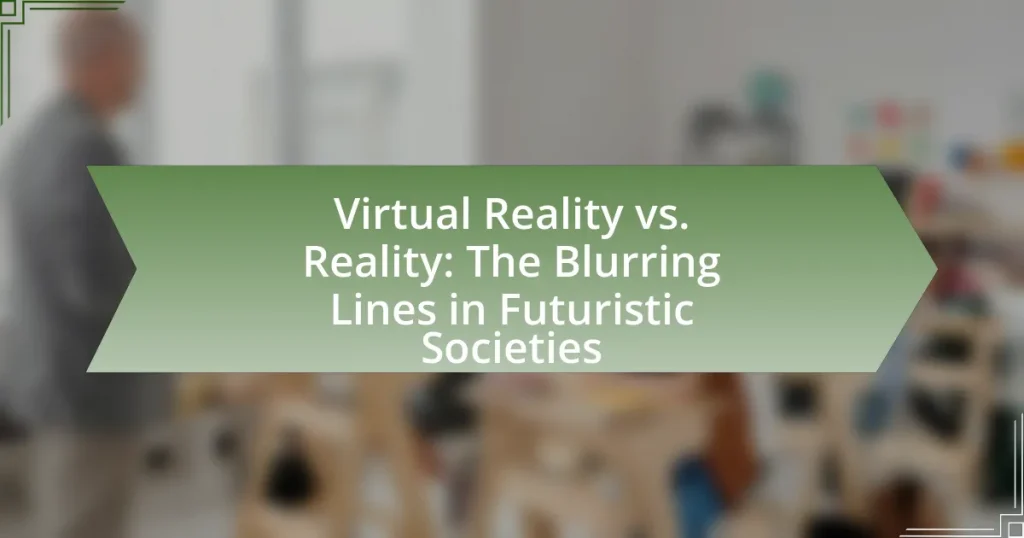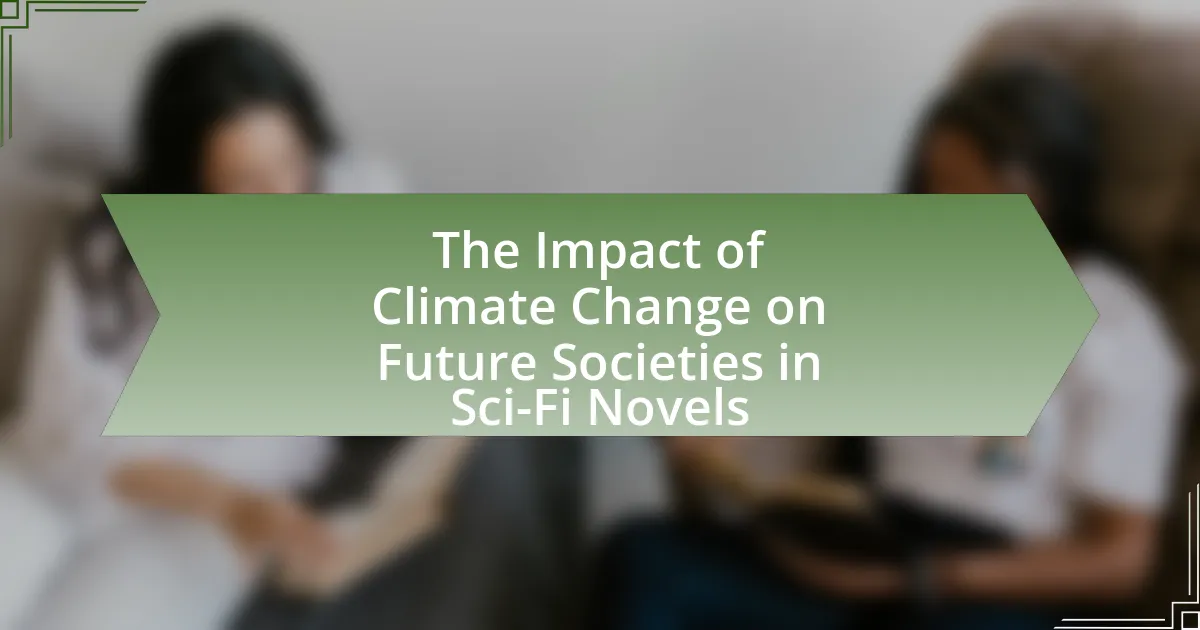The article examines the distinctions and intersections between Virtual Reality (VR) and physical Reality, highlighting how VR creates immersive experiences that differ significantly from real-life interactions. Key differences include sensory engagement, emotional responses, and the unique capabilities of VR to simulate scenarios unattainable in the physical world. The discussion also addresses the technological advancements that blur the lines between these realities, societal influences on perceptions of VR, and the implications for mental health and social dynamics. Additionally, the article explores ethical considerations, privacy concerns, and best practices for responsible VR usage, providing a comprehensive overview of the evolving relationship between virtual and real environments.
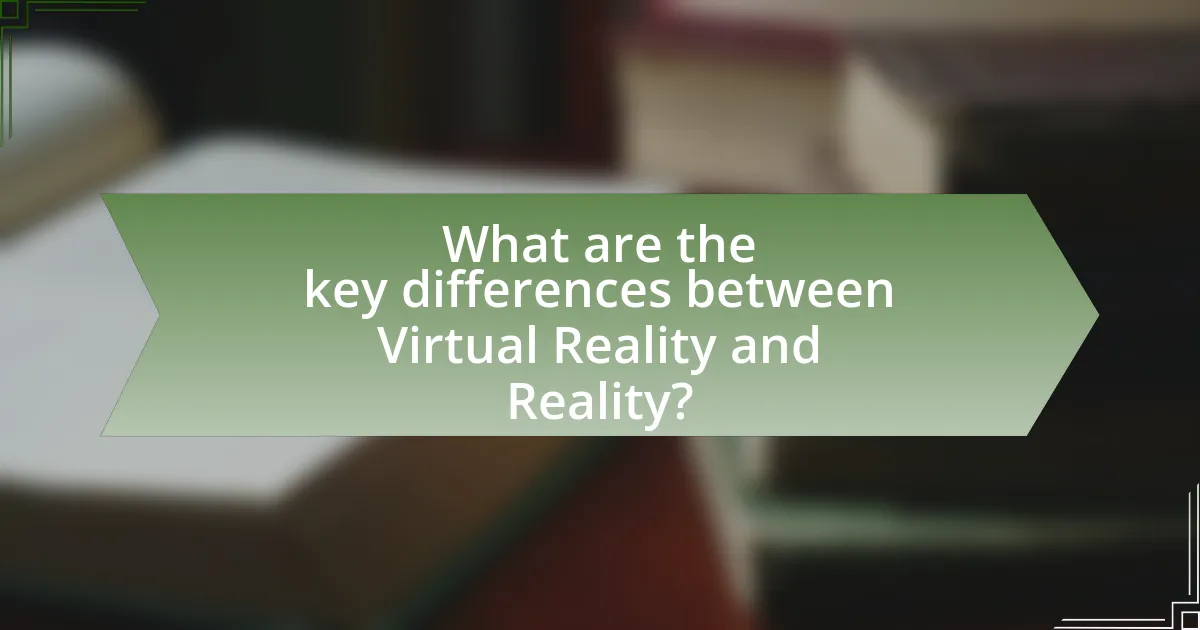
What are the key differences between Virtual Reality and Reality?
Virtual Reality (VR) is a computer-generated simulation that immerses users in a three-dimensional environment, while Reality refers to the physical world experienced through the senses. The key differences include sensory engagement, where VR provides a controlled, artificial experience that can manipulate visual and auditory stimuli, whereas Reality is influenced by natural sensory input and external factors. Additionally, VR allows for experiences that may be impossible in Reality, such as flying or exploring fictional worlds, while Reality is constrained by physical laws and limitations. These distinctions highlight how VR can create unique experiences that diverge significantly from everyday life.
How do Virtual Reality experiences compare to real-life experiences?
Virtual Reality experiences differ from real-life experiences primarily in their sensory immersion and interactivity. While real-life experiences engage all five senses in a natural environment, Virtual Reality primarily stimulates visual and auditory senses through digital simulations. Research indicates that immersive VR can evoke emotional responses similar to real-life situations, as shown in a study by Slater et al. (2009), which found that participants experienced significant emotional engagement in VR scenarios akin to real-world experiences. However, VR lacks the full sensory richness and unpredictability of real life, which can limit the depth of emotional and social interactions.
What sensory elements are present in Virtual Reality that differ from Reality?
Virtual Reality (VR) incorporates sensory elements such as haptic feedback, immersive audio, and visual depth perception that differ significantly from physical reality. Haptic feedback in VR provides tactile sensations through controllers or wearables, allowing users to feel virtual objects, which is absent in traditional reality. Immersive audio in VR utilizes spatial sound technology to create a 360-degree auditory experience, enhancing the sense of presence, while real-world audio is typically less directional. Additionally, VR employs stereoscopic displays to create depth perception, simulating three-dimensional environments, which contrasts with the flat visual experience of screens in reality. These sensory elements collectively enhance user engagement and immersion in virtual environments, making the experience distinct from actual physical interactions.
How does immersion in Virtual Reality affect perception of Reality?
Immersion in Virtual Reality (VR) significantly alters an individual’s perception of reality by creating a convincing sensory experience that can lead to altered cognitive and emotional responses. Research indicates that high levels of immersion can result in a phenomenon known as “presence,” where users feel as though they are truly part of the virtual environment, which can blur the lines between actual and virtual experiences. For instance, a study by Slater and Wilbur (1997) demonstrated that participants reported feeling a strong sense of presence in VR environments, which influenced their emotional reactions and decision-making processes, suggesting that immersive VR can effectively modify users’ perceptions of reality.
Why is the distinction between Virtual Reality and Reality becoming less clear?
The distinction between Virtual Reality and Reality is becoming less clear due to advancements in technology that enhance immersive experiences. Technologies such as high-resolution displays, haptic feedback, and artificial intelligence create environments that closely mimic real-life sensations and interactions. For instance, the use of virtual reality headsets has increased significantly, with the global market projected to reach $57.55 billion by 2027, indicating a growing integration of virtual experiences into daily life. This convergence leads to blurred lines as users increasingly find it difficult to differentiate between virtual interactions and real-world experiences.
What technological advancements are contributing to this blurring of lines?
Technological advancements such as augmented reality (AR), virtual reality (VR), artificial intelligence (AI), and mixed reality (MR) are significantly contributing to the blurring of lines between virtual and physical realities. AR enhances the real world by overlaying digital information, allowing users to interact with both environments simultaneously. VR immerses users in entirely digital environments, creating experiences that can feel indistinguishable from reality. AI enhances these technologies by enabling more realistic interactions and adaptive environments, while MR combines elements of both AR and VR, allowing for seamless interaction between real and virtual objects. These advancements are reshaping perceptions of reality, as evidenced by the increasing use of these technologies in gaming, training simulations, and social interactions, leading to a more integrated experience of both worlds.
How do societal changes influence perceptions of Virtual Reality and Reality?
Societal changes significantly influence perceptions of Virtual Reality (VR) and Reality by shaping cultural norms, technological acceptance, and user expectations. For instance, the rise of remote work and social distancing during the COVID-19 pandemic accelerated the adoption of VR technologies for social interaction and collaboration, leading to a more favorable view of VR as a viable alternative to physical presence. Research from the Pew Research Center indicates that 54% of Americans believe that VR will become a common part of daily life in the future, reflecting a shift in societal attitudes towards immersive technologies. Additionally, as younger generations, who are more accustomed to digital environments, become the primary consumers, their acceptance of VR as a legitimate form of experience further blurs the lines between VR and Reality.
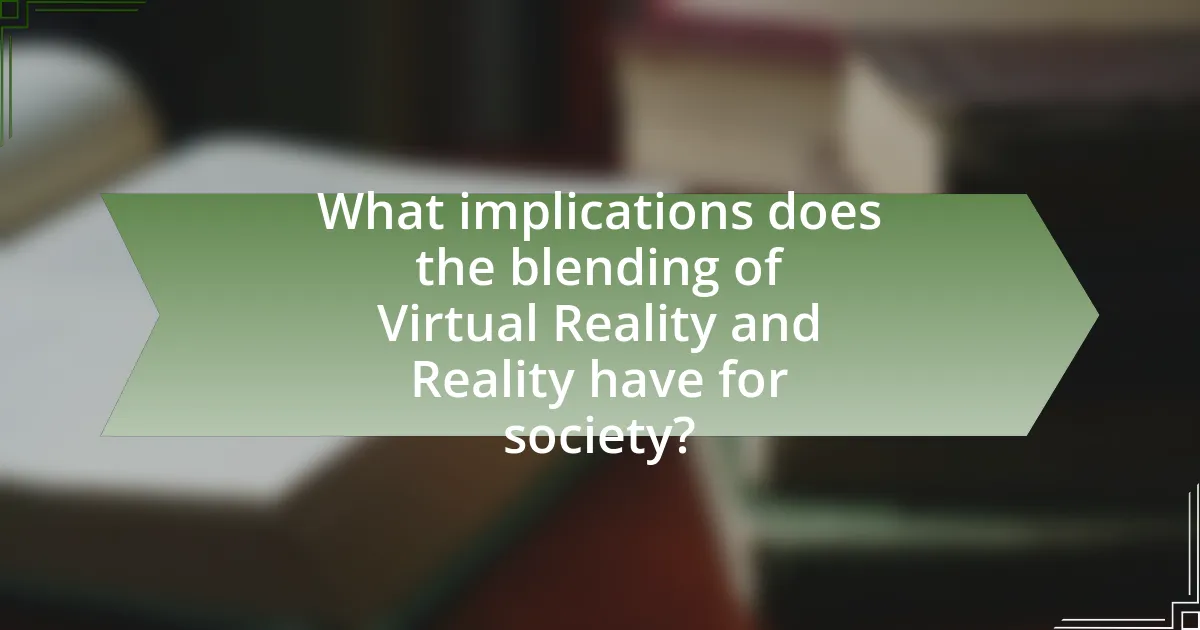
What implications does the blending of Virtual Reality and Reality have for society?
The blending of Virtual Reality and Reality has significant implications for society, including changes in social interaction, mental health, and economic structures. As individuals increasingly engage with immersive environments, traditional forms of communication may diminish, leading to potential isolation or altered social dynamics. Research indicates that excessive use of virtual environments can contribute to mental health issues, such as anxiety and depression, as users may struggle to differentiate between virtual experiences and real-life situations. Economically, industries such as entertainment, education, and healthcare are being transformed, with virtual platforms creating new job opportunities while also displacing traditional roles. For instance, a report by PwC highlights that virtual reality could contribute $1.5 trillion to the global economy by 2030, showcasing its potential to reshape economic landscapes.
How might this blending affect mental health and well-being?
The blending of virtual reality and reality may significantly impact mental health and well-being by altering perceptions of self and environment. This integration can lead to increased feelings of isolation, as individuals may prefer virtual interactions over real-life connections, potentially resulting in loneliness and depression. Research indicates that excessive use of virtual environments can contribute to anxiety and social withdrawal, as users may struggle to differentiate between virtual experiences and real-life situations. A study published in the journal “Cyberpsychology, Behavior, and Social Networking” found that individuals who spent more time in virtual environments reported higher levels of social anxiety and lower overall life satisfaction. Thus, while virtual reality offers immersive experiences, its blending with reality poses risks to mental health that warrant careful consideration.
What are the potential risks of excessive immersion in Virtual Reality?
Excessive immersion in Virtual Reality (VR) can lead to several potential risks, including physical discomfort, psychological effects, and social isolation. Physical discomfort may manifest as eye strain, headaches, or motion sickness due to prolonged use of VR headsets, as reported by the American Optometric Association, which highlights that extended screen time can negatively impact visual health. Psychologically, users may experience dissociation or difficulty distinguishing between virtual and real environments, which can lead to anxiety or depression, as noted in a study published in the journal “Cyberpsychology, Behavior, and Social Networking.” Additionally, excessive VR use can result in social isolation, as individuals may prioritize virtual interactions over real-life relationships, potentially leading to loneliness and decreased social skills, a concern raised by researchers at the University of California, Irvine.
How can Virtual Reality be used positively to enhance mental health?
Virtual Reality (VR) can be used positively to enhance mental health by providing immersive therapeutic environments that facilitate exposure therapy, mindfulness practices, and social interactions. Research indicates that VR exposure therapy effectively treats conditions such as post-traumatic stress disorder (PTSD) and anxiety disorders by allowing patients to confront fears in a controlled setting, leading to reduced symptoms. A study published in the journal “Cyberpsychology, Behavior, and Social Networking” by Difede and Hoffman (2014) demonstrated that patients with PTSD showed significant improvement after undergoing VR therapy. Additionally, VR applications can promote mindfulness and relaxation, helping users manage stress and anxiety through guided meditations in calming virtual environments. Furthermore, VR can foster social connections for individuals with social anxiety or those who are isolated, enabling them to engage in virtual communities and practice social skills.
What ethical considerations arise from the merging of Virtual Reality and Reality?
The merging of Virtual Reality and Reality raises significant ethical considerations, primarily concerning consent, privacy, and psychological impact. Consent becomes complex as users may not fully understand the implications of their interactions in virtual environments, leading to potential exploitation or manipulation. Privacy issues arise when personal data is collected and utilized within virtual spaces, often without explicit user awareness or agreement. Additionally, the psychological impact on users can be profound, as immersion in virtual environments may blur the lines between reality and fantasy, potentially leading to addiction or altered perceptions of real-world relationships and experiences. These considerations necessitate careful ethical scrutiny to ensure responsible development and use of these technologies.
How do privacy concerns manifest in Virtual Reality environments?
Privacy concerns in Virtual Reality environments manifest primarily through data collection, user tracking, and potential exposure of personal information. In these immersive settings, users often share sensitive data, including biometric information and behavioral patterns, which can be exploited by developers or third parties. For instance, a study by the University of California, Berkeley, highlights that VR platforms can collect extensive user data, raising alarms about consent and data security. Furthermore, the immersive nature of VR can lead to unintentional sharing of personal experiences, as users may not fully comprehend the implications of their interactions within these environments. This combination of extensive data collection and the potential for misuse underscores the significant privacy risks associated with Virtual Reality.
What responsibilities do developers have in creating Virtual Reality content?
Developers have the responsibility to ensure that Virtual Reality content is immersive, user-friendly, and ethically sound. They must create engaging experiences that leverage the unique capabilities of VR technology, such as 3D spatial audio and realistic graphics, to enhance user interaction. Additionally, developers are tasked with prioritizing user safety and comfort, which includes minimizing motion sickness and ensuring accessibility for diverse audiences. Ethical considerations also play a crucial role, as developers must avoid content that could promote harmful behaviors or misinformation. These responsibilities are essential for fostering a positive and responsible VR environment, as evidenced by industry guidelines and best practices established by organizations like the International Virtual Reality Developers Association.
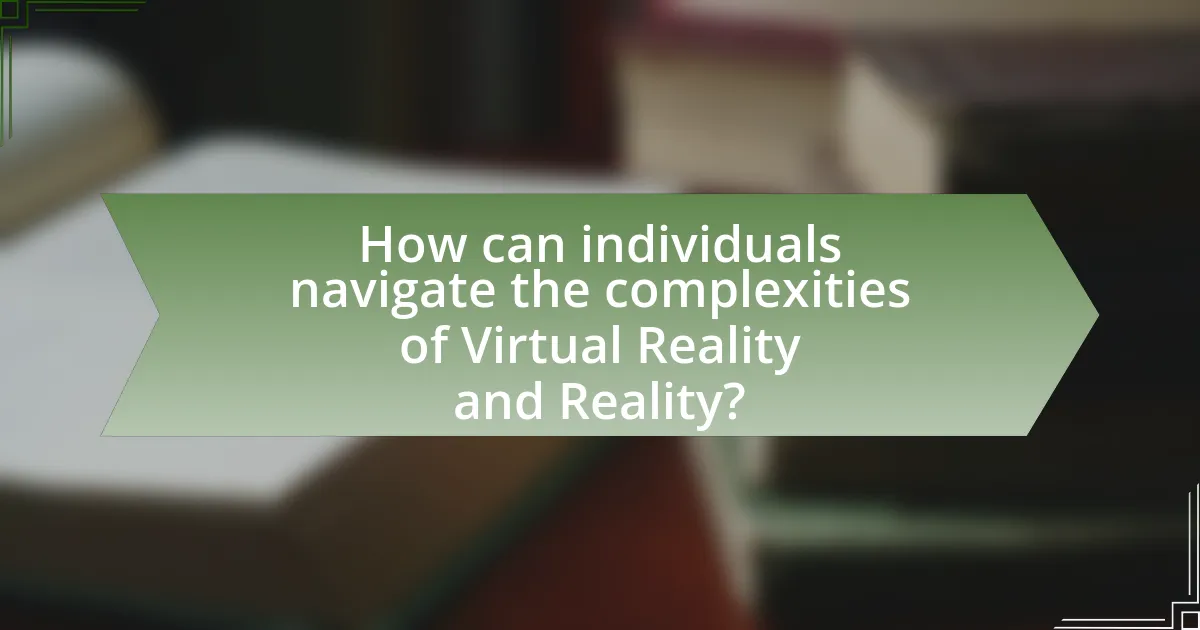
How can individuals navigate the complexities of Virtual Reality and Reality?
Individuals can navigate the complexities of Virtual Reality (VR) and Reality by developing critical thinking skills and establishing clear boundaries between the two environments. Critical thinking enables individuals to assess the authenticity and implications of experiences in VR, allowing them to differentiate between simulated and real-life scenarios. Establishing boundaries involves setting specific times and contexts for engaging with VR, which helps maintain a healthy balance and prevents immersion from negatively impacting real-world responsibilities and relationships. Research indicates that excessive VR use can lead to disorientation and difficulty in distinguishing reality, emphasizing the importance of these strategies for effective navigation.
What strategies can be employed to maintain a healthy balance between Virtual Reality and Reality?
To maintain a healthy balance between Virtual Reality and Reality, individuals should establish time limits for VR usage. Research indicates that excessive VR exposure can lead to disorientation and detachment from the physical world. Setting specific time frames for VR activities, such as using the 20-20-20 rule—taking a break every 20 minutes to look at something 20 feet away for 20 seconds—can help mitigate these effects. Additionally, engaging in regular physical activities and social interactions in the real world reinforces connections to reality, promoting mental well-being. Studies show that a diverse range of activities, including outdoor experiences and face-to-face interactions, enhances cognitive function and emotional health, thereby supporting a balanced lifestyle.
How can users set boundaries for their Virtual Reality usage?
Users can set boundaries for their Virtual Reality (VR) usage by establishing specific time limits for sessions and designating physical spaces for VR activities. Setting a timer for VR sessions can help prevent excessive use, as studies indicate that prolonged VR exposure can lead to disorientation and fatigue. Additionally, creating a dedicated area for VR can help users mentally separate their immersive experiences from daily life, reducing the likelihood of overindulgence. Research shows that maintaining a balance between virtual and real-world interactions is crucial for mental well-being, emphasizing the importance of these boundaries.
What role does community play in supporting healthy Virtual Reality engagement?
Community plays a crucial role in supporting healthy Virtual Reality (VR) engagement by providing social interaction, shared experiences, and emotional support. Engaging with a community enhances the VR experience, as users can collaborate, compete, and communicate, which fosters a sense of belonging and reduces feelings of isolation. Research indicates that social presence in VR environments can lead to increased user satisfaction and prolonged engagement, as seen in studies like “The Role of Social Presence in Virtual Reality” by Bailenson et al., which highlights how community interactions can enhance the immersive experience. Furthermore, communities can establish norms and guidelines that promote responsible usage, helping users navigate potential risks associated with excessive VR engagement.
What resources are available for understanding the impact of Virtual Reality on daily life?
Resources available for understanding the impact of Virtual Reality (VR) on daily life include academic journals, books, online courses, and industry reports. Academic journals such as “Virtual Reality” and “Journal of Augmented and Virtual Reality” publish peer-reviewed studies that explore VR’s effects on social interaction, mental health, and education. Books like “The Infinite Retina” by David J. Chalmers provide insights into the philosophical implications of VR. Online platforms like Coursera and edX offer courses on VR technology and its applications, while industry reports from organizations like PwC and McKinsey analyze VR’s economic impact and future trends. These resources collectively contribute to a comprehensive understanding of how VR influences various aspects of daily life.
Where can individuals find reliable information on Virtual Reality technologies?
Individuals can find reliable information on Virtual Reality technologies through reputable sources such as academic journals, industry reports, and established technology websites. For instance, the IEEE Xplore Digital Library provides access to peer-reviewed articles on VR advancements, while the Virtual Reality Developers Conference (VRDC) offers insights from industry leaders. Additionally, organizations like the International Virtual Reality Developers Association publish research and guidelines that are credible and informative. These sources ensure that the information is accurate and up-to-date, reflecting the latest developments in Virtual Reality technologies.
What are some best practices for safe and responsible Virtual Reality use?
Best practices for safe and responsible Virtual Reality (VR) use include maintaining a clear physical play area, taking regular breaks, and being aware of one’s surroundings. A clear play area minimizes the risk of injury by ensuring users do not collide with objects or people while immersed in VR. Taking breaks, recommended every 30 minutes, helps prevent motion sickness and eye strain, which are common issues associated with prolonged VR use. Additionally, being aware of surroundings prevents accidents and enhances user safety, as users can remain conscious of their real-world environment while engaged in virtual experiences. These practices are supported by guidelines from organizations such as the American Optometric Association, which emphasizes the importance of eye health and safety in VR usage.
